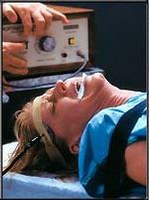31 May 2007: Receiving hundreds of forced electroshocks for years against the expressed wishes of the subject is becoming the “norm” for some mental health clients in New York State psychiatric institutions, says attorney Dennis Feld. In this news release Mr. Feld announces he will be arguing for the right of his client — Simone D. — to resist more forced electroshock in a New York State High Court.
News Release from Dennis Feld, Deputy Director of New York State Mental Hygiene Legal Service (MHLS)
Simone D. appeal
by Dennis Feld – dbfeld@courts.state.ny.us
On Thursday, May 31, 2007, New York State’s High Court, the Court of Appeals in Albany, will hear argument for the first time on the subject of ECT, and in the Simone D. appeal, its involuntary administration.
Twenty-one years after that Court issued it’s seminal ruling in Rivers v. Katz, dealing with the involuntary administration of psychotropic medication, the Court will finally entertain another appeal regarding forcible psychiatric treatment.
The stakes are extremely high, especially with the State Office of Mental Health vigorously, and without shame, pursuing the practice of involuntary maintenance shock where the performance of over 200 to 300 shocks on an individual patient over the course of that person’s stay at the State hospital (usually involving several years) is more the norm than the rare exception.
An Amicus brief will likely be filed on behalf of Simone D. John Gresham, of New York Lawyers for the Public Interest, will be authoring it with NARPA [National Association for Rights Protection and Advocacy], Bazelon, and a few other organizations joining as amici.
John’s medical research shows that the efficacy of such high numbers of shock is questioned by the psychiatrists in the U.S. and rejected by their colleagues in England. And John quotes ECT proponent Harold Sackheim regarding cognitive damage following even an acute series of shock.
Of course, the story of Simone D. as a human being facing a lifetime of ECT, with little or no chance of remission or discharge from her involuntary stay at the hospital, is not lost either in John’s proposed brief or the main Appellant’s Brief filed by her counsel, Mental Hygiene Legal Service and crafted by Kim Darrow with my assistance.
Even if the reversal of the Appellate Division’s affirmance of the trial court’s order authorizing 30 more shocks on Simone D. is centered on the more narrow legal issue of the hearing judge’s limitation on Simone D.’s counsel’s cross-examination, including the inquiry into the drugs used in ECT to suspend a patient’s respiration and the FDA’s classification of the ECT machine as a dangerous medical instrumentality, this would be a great victory and a major lost for institutional psychiatry and it’s we are free to try anything approach.
Document Actions


